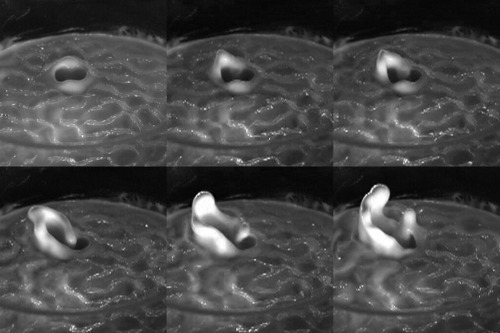Handling Editor: Evelyn Sander
Viscosity movie: a big hit on YouTube
Robert Deegan,
Department of Physics and
Center for Study of Complex
Systems,
University of Michigan
On the morning of May 5, 2004 the web server for the Center for Nonlinear Dynamics
(CNLD) was farked. To be "farked" is to be overwhelmed by hits from
surfers following a link posted on Fark.com. Overnight the CNLD server
received over 50,000 hits, and was paralyzed by the load. The link at CNLD
was to a video made by me, Florian Merkt, and Harry Swinney of pattern
formation in a vibrated cornstarch solution.
This video was prepared as an entry to Annual Gallery of Fluid Motion
competition. At the 2003 Division of Fluid
Mechanics meeting the submissions were judged, and mine was found wanting.
Disappointed I returned to Texas, put the video on my webpage, and forgot about it
until the morning of May 5. The video has since acquired a life of its own. Sometime in
2006 I first learned of YouTube when a friend told me that my video was playing there.
The video has been uploaded to YouTube
multiple times (my personal favorite
is the "blues" version), and has
been viewed over 1.5 million times.
Cornstarch is a granular material with grains on the order of 10 microns. When mixed
with water it forms a solution that shear thickens, i.e. its viscosity increases with shear
rate. For a highly concentrated solution this effect is highly pronounced. Over a narrow
window in shear rate the material practically solidifies. (If you have never experienced
this yourself, I highly recommend it. You probably already have cornstarch sitting in
your kitchen. Mix it with a little water, and stir.) The solution featured in the video is
far more dilute than this, and exhibits only a tenfold increase in viscosity.

A vibrated layer of cornstarch in water exhibiting holes. Image by F. Merkt, R.D. Deegan, D. Goldman, E. Rericha,
and H.L. Swinney [1].
Our video shows the phenomenon of
holes and fingers in a vibrated cornstarch solution. (I recommend watching the video
before continuing as it does far better justice to the phenomena that my written words
will.) In our experiments a container of this fluid is vibrated vertically. Any vertically
vibrated liquid above an acceleration threshold develops surface waves. These waves
were first observed by Faraday, and have since been extensively studied for their
intrinsic interest and as a model pattern forming system. Using cornstarch adds an extra
wrinkle to this scenario: applying a large perturbation to the surface produces a hole, a
cylindrical void from the liquid surface down to the bottom of the container that persists
indefinitely. This behavior is in striking contrast a Newtonian fluid. Consider for example
a cavity created by the impact of an object with a liquid. For a Newtonian fluid the cavity
collapses, and all traces of the impact eventually disappear. For a cornstarch solution
the application of vibrations stabilizes the cavity so that it remains open indefinitely.

A vibrated layer of cornstarch in water at the onset
of delocalization of a hole. These photographs were taken every 0.9 seconds.
Time increases from left to right and top to bottom. Image by F. Merkt [1].
Holes are examples of dissipative solitons. A dissipative soliton is a localized state like
its classical analogue but is sustained by the input of energy rather than nonlinear
focusing. An important distinction from the classical soliton is that dissipative solitons
do not require special initial conditions to form. The notion of dissipative soliton is
gaining traction in the scientific and mathematical literature, and many examples are
now known such as in laser systems, reaction‐diffusion systems, granular materials (see [2]
for a recent review).
Holes are not the only nor the most popular feature that appears in a vibrated
cornstarch solution. As the acceleration is increased, the holes lose stability, and a
finger‐like protrusion begins growing on the rim of the hole. The protrusion continues
to grow, reaches a maximum height, and falls over. The remnant of this finger seeds the
growth of another, and soon the entire surface becomes a writhing mass. The
popularity of the video is due to this phenomenon. A surprising number of viewers
think it is faked.
The video has inspired a number of people to do their own experiments, and post them
on YouTube. I receive a dozen or so requests a year for information on how to
duplicate the experiment, and I've now started a collaboration with the San Francisco
Exploratorium based on this experiment. Though I now cringe when I hear my clunky
narration on the video and feel awkward when I am introduced as someone with a
million hit YouTube video, the popularity of the video on YouTube has been a pleasant
windfall for me both personally and professionally.
References
| [1] |
|
F. Merkt, R.D. Deegan, D. Goldman, E. Rericha, and H.L. Swinney,
"Persistent holes in a fluid," Phys. Rev. Letters. 92 184501 (2004).
|
| [2] |
N. Akhmediev & A. Ankiewicz, Dissipative Solitons,
Springer, New York, 2005.
|